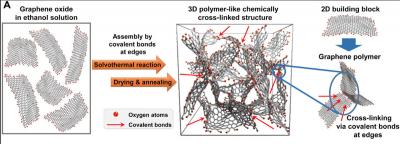Researchers from Nankai University in China and Rice University in the U.S. have developed a type of graphene-based foam that retains its texture when exposed to extremely cold temperatures.
 Structure of the 3D graphene foam
Structure of the 3D graphene foam
The researchers note that almost all materials become more brittle and stiffer when exposed to very cold temperatures, often leading to loss of strength. In this new work, the researchers sought to find a material that would spring back after being crushed while exposed to extreme temperatures. To that end, they turned to graphene as a possible solution.
The researchers tested their foam by exposing it to both very high and low temperatures and then compressing it multiple times using a compression device they built. They report that their foam behaved the same at -269.15 degrees C as it did at room temperature. After compression to just a tenth of its original size, it popped right back nearly to its original shape. They report also that the foam performed well at high temperatures. When heated to 1000 degrees C it performed nearly as well on the compression tests as it did at room temperature.
The researchers stated their foam demonstrates that using super-thin materials like graphene can give rise to a foam with a unique propertyâthey claim this might also be the case for other materials, such as those made with 2D semiconductors or inorganic compounds. They also note their foam might prove useful for creating materials for use in space.